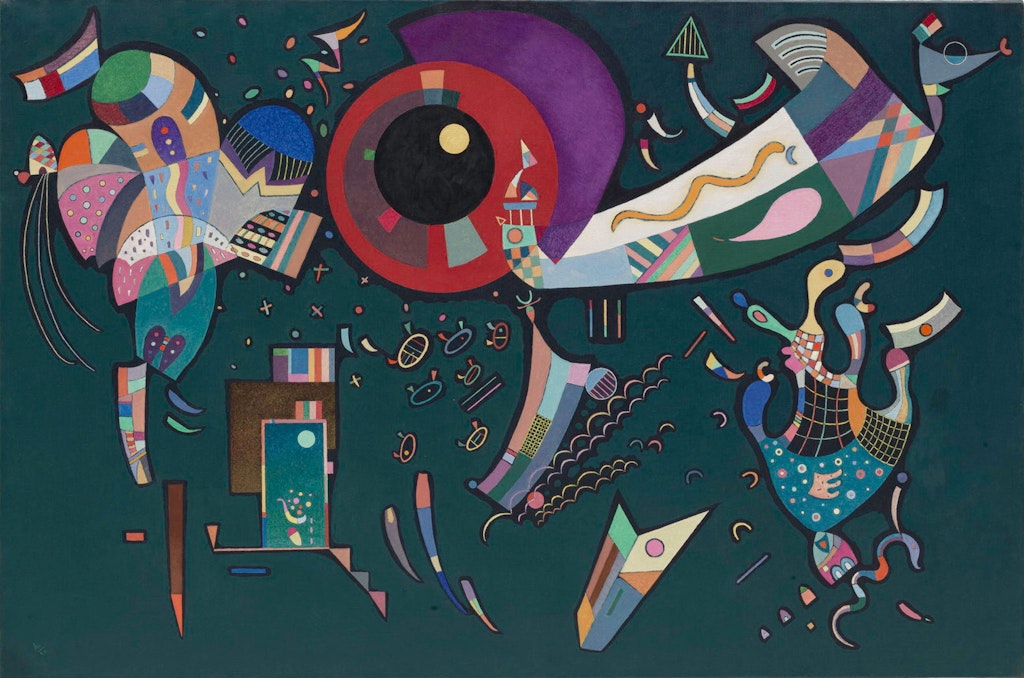Final years
Every serious work of art has an inner sound like the peaceful and exalted words, ‘I am here’.
In December 1933, Kandinsky and his wife, Nina, settled in a suburb of Paris, where he was highly creative despite political turmoil and deprivation. The artist increasingly experimented with materials, creating imaginative works with enamel paint, or pigments combined with sand. His compositions from this period resemble miniscule worlds of living organisms, clearly informed by his contact with surrealism, and an interest in natural sciences, particularly embryology, zoology and botany.
During World War II, German authorities confiscated and declared Kandinsky’s work ‘degenerate’, and Stalinists in the Soviet Union closed museums, sending many of his canvases into storage. His work in this final period grew smaller in scale, and Kandinsky often worked on board due to wartime canvas shortages. He died in Paris in 1944 at age 78.

Vasily Kandinsky Around the circle May–August 1940, oil and enamel on canvas, 97.2 x 146.4 cm, Solomon R. Guggenheim Museum, New York, Solomon R. Guggenheim Founding Collection 1949
Around the circle reflects not only contemporary concerns but also Kandinsky’s abiding interest in the belief systems and folklore of Russian and Siberian cultures. The dominant red circle at top centre, the form cresting the undulating lines of ‘sacred waters’ below, and an upside-down stylised humanoid form at bottom right have all been interpreted as potential allusions to shamans, or spiritual leaders and healers, in states of transformation.
At bottom left, a lunar orb glows in the expanse beyond an open doorway, which is connected to a set of stairs with no physical support. This could be a portal to the cosmos, or some indeterminate space beyond the picture plane, in a probable nod to alternate dimensions or the capacity for mystical ascendance.
Speaker 1: There’s this little door that’s leading outside. I thought it could be a, the stairs were a passage way up to the door that then leads either into another painting or out of the painting into another world or our world even. It reminds me of an old fashioned arcade game with like alien spaceships and interesting spacey houses.
Speaker 2: I think people should think about why he made these objects like they are or if they actually look like other things.
Speaker 3: If people just catch their eye onto it, I think they’ll feel like calm and creative and like they want to create a painting like this one.
-
01
Listen to Years 5 and 6 students respond to ‘Around the circle’
-
K–6 discussion questions
Describe the colours Kandinsky has used in Around the circle May–August 1940. List the colours in the foreground and background. Do the colours or colour relationships feel new to you compared to his earlier work? Which period in Kandinsky’s career do they resemble the most? Share your thoughts and ideas with the class.
What do the forms, lines and shapes remind you of in Around the circle? This artwork feels like a puzzle or a kind of coded language. Can you solve the puzzle or understand the language? Or is it something of a mystery? Would it matter to Kandinsky if you could solve it? Why do you think this way?
-
K–6 activities
In Around the circle May–August 1940, Kandinsky places a portal or open door in the composition with a staircase leading up to it. What world exists behind this open door? Create an artwork based on your idea. Take inspiration from Kandinsky’s use of colour and form.
At this stage in Kandinsky’s life, he returns to his favourite Russian stories. Think about your favourite folktale or mythical story and create an abstract artwork that depicts the narrative or characters.
-
7–12 discussion questions
Discuss the role Kandinsky has played in influencing generations of artists after him. Compare his work to the abstract expressionists, for example. Can you see his influence on postmodern artists? Present your findings to the class.
In response to Kandinsky’s art, the Mexican painter Diego Rivera said that ‘a painting by Kandinsky gives no image of earthly life – it is life itself’. Does this add to your thoughts on Kandinsky’s late paintings? Do you agree or disagree with Rivera? How do you think Kandinsky would respond to this statement?
In his early work, Kandinsky captured the energy and dynamism of nature, and at the Bauhaus he turned to the language of form. At the end of his career, he united these elements towards the expression of the truly spiritual in art, which was his lifelong aim. Can you see this progression through his body of work? Choose examples to justify your point of view.
-
7–12 activities
In his final years, Kandinsky returns to the shamanic themes motifs and colours that appeared in his early career. Find an artwork you created when you were younger. Build a body of work inspired by this artwork layered with who you are today.
The circle had symbolic, cosmic meanings to Kandinsky and it represented the past and the present to him. What does the main circle in this composition make you think of? Write a narrative inspired by this artwork and have the circle as the main part of the storyline.